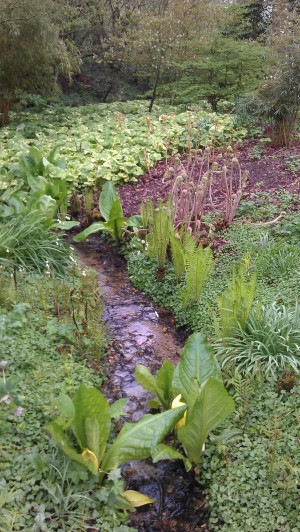I had the pleasure of exploring two wonderful woodland gardens in two weekends recently. On April 26th I went to Beth Chatto’s gardens near Colchester and on May 2nd I visited Evenley Wood Gardens in South Northamptonshire. This post is about Beth Chatto’s woodland garden and I will write up my visit to Evenley shortly.
Spring is prime time for woodland flowers, as they flower before the tree canopy covers the ground in shade. By mid spring, the trees are starting to put on new leaves, so you get the flowers slightly over their best but still blooming, in addition to the beauty of the fresh new tree leaves. Carpets of bluebells are of course the crowning glory, but these visits did not feature bluebells: they were glorious in other ways, and full of useful ideas of what to plant in dappled shade in your own garden.
Beth Chatto has become famous for her ability to grow plants in difficult places. It seems to me that she has widened our horizons, along with people like Margery Fish, so that we no longer think of planting in the shade, or in damp spots, or dry areas, as something to avoid. These places have become exciting opportunities to grow new things, thanks to the interest she and her husband took in how to choose plants to suit their environment.
Mrs Chatto had already started her gardens when there was a great storm, which blew down many trees in the woodland area. She had previously left this expanse as a wild area, however now the trees had fallen, the shade was lighter, allowing a wider variety of plants to grow. So she established different layers of planting: the existing tall trees remained the top layer, followed by smaller trees, often with conspicuous flowers, then shrubs and then ground level plants. Here is a general view of part of the woodland:
Here is an example of the shrub layer: this is exochorda macrantha ‘The Bride”.
This beautiful shrub can be grown in gardens as well as woodland. The RHS suggests sites including ‘Low Maintenance, Architectural, City & Courtyard Gardens, Cottage & Informal Garden, Patio & Container Plants’ so it is versatile.
Going down from shrub height there will be gunnera, now sprouting innocently from the ground as if it will only reach knee high, but by summer it will be over our shoulders like monstrous rhubarb-leaf umbrellas (see my second post about Cottesbrooke Gardens for examples).
At knee height are, or will shortly be, the ferns. They are already beautiful, the ‘fiddles’ as country people call them, reaching up vertically by the streams and ponds here, in contrast with blossom dangling down overhead.
 People tend not to use deciduous ferns, wanting evergreen colour, but what about the excitement of the spring unfurling of these tight little bronze spirals of leaf? And the patterns of the upward-growing stalks? Here Beth has planted it next to pale variegated water iris or acorus (I am not sure which, but the variegated colour is the thing).
People tend not to use deciduous ferns, wanting evergreen colour, but what about the excitement of the spring unfurling of these tight little bronze spirals of leaf? And the patterns of the upward-growing stalks? Here Beth has planted it next to pale variegated water iris or acorus (I am not sure which, but the variegated colour is the thing).
The bottom storey of the garden is composed of a wide range of ground cover plants, planted to show off their different shapes and colours. Here the deep purple of the persicarias contrasts with the bright lemony green-yellow of what I think is a philadelphus coronarius ‘Aureus’. The latter will produce white flowers with a beautiful scent in early summer.
 Here the rounded fleshy leaves of bergenia contrast with the golden millet grass (millium effusum ‘Aureum’) which in turn looks good against the spotty green leaves of lungwort (pulmonaria). The hellebores are still in flower behind them.
Here the rounded fleshy leaves of bergenia contrast with the golden millet grass (millium effusum ‘Aureum’) which in turn looks good against the spotty green leaves of lungwort (pulmonaria). The hellebores are still in flower behind them.
Last but not least, two showy plants for this time of year:- the bright yellow skunk cabbage (lysichiton) by the stream:
and the spectacular American native, the trillium:
As you can see, this is not currently for sale in the nursery! We were not deterred, however, and rounded off our trip with a nursery visit and had Sunday lunch at the tearooms; an excellent morning out.





